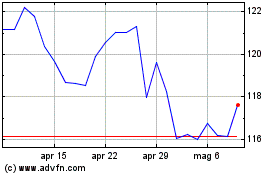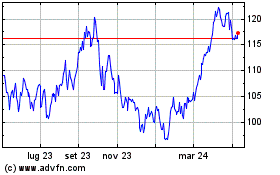ExxonMobil to Expand Advanced Recycling Capacity
21 Novembre 2024 - 2:00PM
Business Wire
Plans for 1 Billion Pounds Capacity per Year
by 2027
- $200 million investment adds new units to Beaumont and Baytown
sites
- Processed more than 70 million pounds of plastic waste in
Baytown so far with proven technology
- Additional advanced recycling units planned for North America,
Europe, Asia
ExxonMobil (NYSE: XOM) plans to invest more than $200 million to
expand its advanced recycling operations at its sites in Baytown
and Beaumont, Texas. The new operations are expected to start up in
2026 and can help increase advanced recycling rates and divert
plastic from landfills. The company plans to build additional units
to reach a global recycling capacity of 1 billion pounds per year
by 2027.
“We are solutions providers, and this multi-million-dollar
investment will enhance our ability to convert hard-to-recycle
plastics into raw materials that produce valuable new products,”
said Karen McKee, president of ExxonMobil Product Solutions. “At
our Baytown site, we’ve proven advanced recycling works at scale,
which gives us confidence in our ambition to provide the capacity
to process more than 1 billion pounds of plastic per year around
the world. We’re proud of this proprietary technology and the role
it can play in helping establish a circular economy for plastics
and reducing plastic waste.”
The investment will add 350 million pounds per year of advanced
recycling capacity at Baytown and Beaumont, bringing ExxonMobil’s
total capacity to 500 million pounds per year. The company is
continuing to develop additional advanced recycling projects at
manufacturing sites in North America, Europe and Asia, with the
goal of reaching 1 billion pounds per year of recycling capacity
globally by 2027.
ExxonMobil has advanced recycling customers in more than 15
countries across multiple sectors, including food-safe packaging
and pet food, and demand is increasing.
Advanced recycling complements traditional, mechanical recycling
by transforming plastic waste into raw materials that can be used
to make many valuable products – from fuels to lubricants to
high-performance chemicals and plastics. Advanced recycling can
address a broader range of plastic waste that won’t be mechanically
recycled and may otherwise be buried or burned.
Advanced recycling is a vital element of a circular economy.
Circularity includes the entire life cycle of plastics, from
designing products to be more easily recycled to improving waste
management systems.
“The world’s plastic waste challenge will be solved with
innovation, collaboration, and supportive government policy to
improve waste management and circularity,” said McKee. “ExxonMobil
is doing its part by developing scalable technology, investing in
recycling infrastructure and helping our customers meet their
circularity goals.”
The company’s first Baytown facility started up in 2022 and
represents one of the largest advanced recycling facilities in
North America, having processed more than 70 million pounds of
plastic waste as of October 2024. ExxonMobil helped to form joint
venture Cyclyx in 2021 to improve the collection and sortation of
plastic waste.
About ExxonMobil
ExxonMobil, one of the largest publicly traded international
energy and petrochemical companies, creates solutions that improve
quality of life and meet society’s evolving needs.
The corporation’s primary businesses – Upstream, Product
Solutions and Low Carbon Solutions – provide products that enable
modern life, including energy, chemicals, lubricants, and lower
emissions technologies. ExxonMobil holds an industry-leading
portfolio of resources, and is one of the largest integrated fuels,
lubricants, and chemical companies in the world. ExxonMobil also
owns and operates the largest CO2 pipeline network in the United
States.
In 2021, ExxonMobil announced Scope 1 and 2 greenhouse gas
emission-reduction plans for 2030 for operated assets, compared to
2016 levels. The plans are to achieve a 20-30% reduction in
corporate-wide greenhouse gas intensity; a 40-50% reduction in
greenhouse gas intensity of upstream operations; a 70-80% reduction
in corporate-wide methane intensity; and a 60-70% reduction in
corporate-wide flaring intensity.
With advancements in technology and the support of clear and
consistent government policies, ExxonMobil aims to achieve net-zero
Scope 1 and 2 greenhouse gas emissions from its operated assets by
2050. To learn more, visit exxonmobil.com and ExxonMobil’s
Advancing Climate Solutions.
Follow us on LinkedIn.
Cautionary Statement
Statements related to outlooks; projections; descriptions of
strategic, operating, and financial plans and objectives;
statements of future ambitions and plans; and other statements of
future events or conditions, are forward-looking statements.
Forward-looking statements are based on current expectations,
estimates, projections and assumptions at the time the statements
are made. Actual future results, including project plans,
schedules, costs, returns, and capacities and efficiency; ultimate
recoveries; operating performance and demand projections could
differ materially due to factors such as changes in market
conditions affecting the oil, natural gas and petrochemical
industry or changes in prices of oil, gas or petrochemicals;
political or regulatory developments; the availability of
feedstocks; the occurrence and duration of economic recessions;
timely completion of development projects; technical or operating
factors; the outcome of future commercial negotiations, including
final agreed terms and conditions; unforeseen technical or
operating difficulties and unplanned maintenance; and other factors
discussed under the heading "Factors Affecting Future Results" in
the Investor Information section of our website
(www.exxonmobil.com) and in Item 1A of our most recent Form
10-K.
View source
version on businesswire.com: https://www.businesswire.com/news/home/20241121976622/en/
Media Relations 737-272-1452
Grafico Azioni Exxon Mobil (NYSE:XOM)
Storico
Da Dic 2024 a Gen 2025

Grafico Azioni Exxon Mobil (NYSE:XOM)
Storico
Da Gen 2024 a Gen 2025
